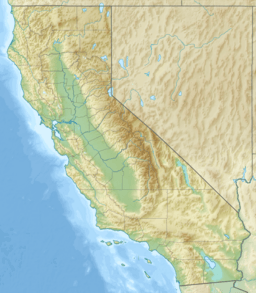Twitchell Reservoir facts for kids
Quick facts for kids Twitchell Reservoir |
|
|---|---|
| Location | San Luis Obispo / Santa Barbara counties, California, United States |
| Coordinates | 34°59′53″N 120°19′59″W / 34.998°N 120.333°W |
| Type | Reservoir |
| Primary inflows | Cuyama River |
| Primary outflows | Terminal (evaporation) / Cuyama River |
| Basin countries | United States |
| Water volume | 225,000 acre⋅ft (278,000,000 m3) |
| Surface elevation | 692 ft (211 m) |
Twitchell Reservoir is a large lake created by a dam in California. It sits between San Luis Obispo and Santa Barbara counties. This reservoir can hold about 197,756 acre⋅ft (243,928,000 m3) of water.
The reservoir was formed by Twitchell Dam, which was built on the Cuyama River. This river flows from the Chumash Wilderness Area. The dam is about 6 miles (9.7 km) from where the Cuyama River joins the Sisquoc River to form the Santa Maria River.
The United States Bureau of Reclamation built Twitchell Dam between 1956 and 1958. At first, the dam and reservoir were called Vacquero Dam and Vacquero Reservoir. Later, their names were changed to honor T. A. Twitchell. He was a person from Santa Maria who strongly supported building the project.
Contents
Why Twitchell Reservoir Is Important
Twitchell Dam and its reservoir have two main jobs. They help control floods and save water. The Central Coast of California gets most of its rain only during the winter. This area usually gets about 14 inches (360 mm) of rain each year.
How the Dam Manages Water
During big winter storms, the dam stores water in the reservoir. Then, this water is released slowly. This slow release lets the water soak into the ground. It helps refill the underground water supply, called groundwater. Because of this, the reservoir is often not completely full.
Experts believe the project adds about 20,000 acre⋅ft (25,000,000 m3) of water to the groundwater each year. This is very helpful for the local area.
Challenges with Sediment
One problem for the reservoir is sediment. Sediment is like dirt and sand that washes into the reservoir. The reservoir is filling up with sediment much faster than expected. This makes the reservoir hold less water. It also blocks the way for water to reach the control gates of the dam.
Sometimes, some sediment is flushed out when water is released. However, much of it just settles downstream. This can cause problems with how the river flows below the dam.
Public Access to the Reservoir
There is no public access to the dam or the reservoir area. This means people cannot visit it directly.




